Czech food offers the perfect antidote to the rigours of healthy eating and nouvelle cuisine: honest, filling, often delicious dishes, based on the kind of recipes grandmother kept to herself. You will also find that prices are still relatively low, and it is possible to eat well for around £10 ($16) per person, although the finest establishments charge significantly more.
Since the Velvet Revolution, Prague has become one of the busiest tourist cities in Europe, and some international chefs and restaurateurs have been quick to take advantage of the new opportunities and charge accordingly. There is a surprising amount of international cuisine available, from sushi to Indian curries.
Where to eat
Prague is generously endowed with places to eat, and now that restaurants no longer have to be licensed by the state; many new establishments have opened as international influences find a foothold in the country. Apart from conventional restaurants (restaurace), which may be exclusive or geared to a regional or foreign cuisine, the following options are worth seeking out:
Vinárny (wine restaurants – on signs you will see the word Vinárna) may have the same menus as ordinary restaurants but place a special emphasis on their wine list. The ambience is often intimate, and possibly historic.
Pivnice or hospody (pubs or taverns) specialise in draught beer and a limited selection of traditional meat platters. The mood is likely to be jolly and the service informal.

Inside one of Prague’s many kavárny (cafés)
Rod Purcell/Apa Publications
Kavárny (cafés) are essentially for snacks and sweet pastries, although you may find some hot meals on the menu. On signs you will see the word Kavárna. If you are in a rush and in need of a quick bite, there is a wide range of cheap fast-food outlets and self-service bistros in the city centre.
The atmosphere in Prague’s eateries is often colourful or romantic, although the standard of service varies. Most waiters will understand a few English phrases, and some will undoubtedly speak very good English; however, learning a few words of Czech will certainly be appreciated. Terrace cafés and restaurants help to minimise the problem. If a restaurant becomes busy it is normal practice for diners to share a table – many pubs have long communal tables that seat 10 or 12 people.
Be aware of the hidden charges added by some eateries and pubs. A cover charge of around 30 Kč per person may be added to the bill. Some budget cafés charge for condiments, while others leave appetisers on the table without telling you that there is a charge for them. Pubs often send waiters out with trays of short drinks, but any drinks you consume will be added to your bill, although these charges will be minimal.
Breakfast
Breakfast (snídaně) is served by hotels from about 6am to 10.30am. In most establishments this will be presented in the form of a buffet, its lavishness depending on the class of the hotel. There will always be tea and coffee, a choice of cereals, cold meats, cheese, eggs, yoghurt and fruit. Check whether the price of breakfast is included in the room rate. If not, there is the option of eating out at one of the American-style diners.
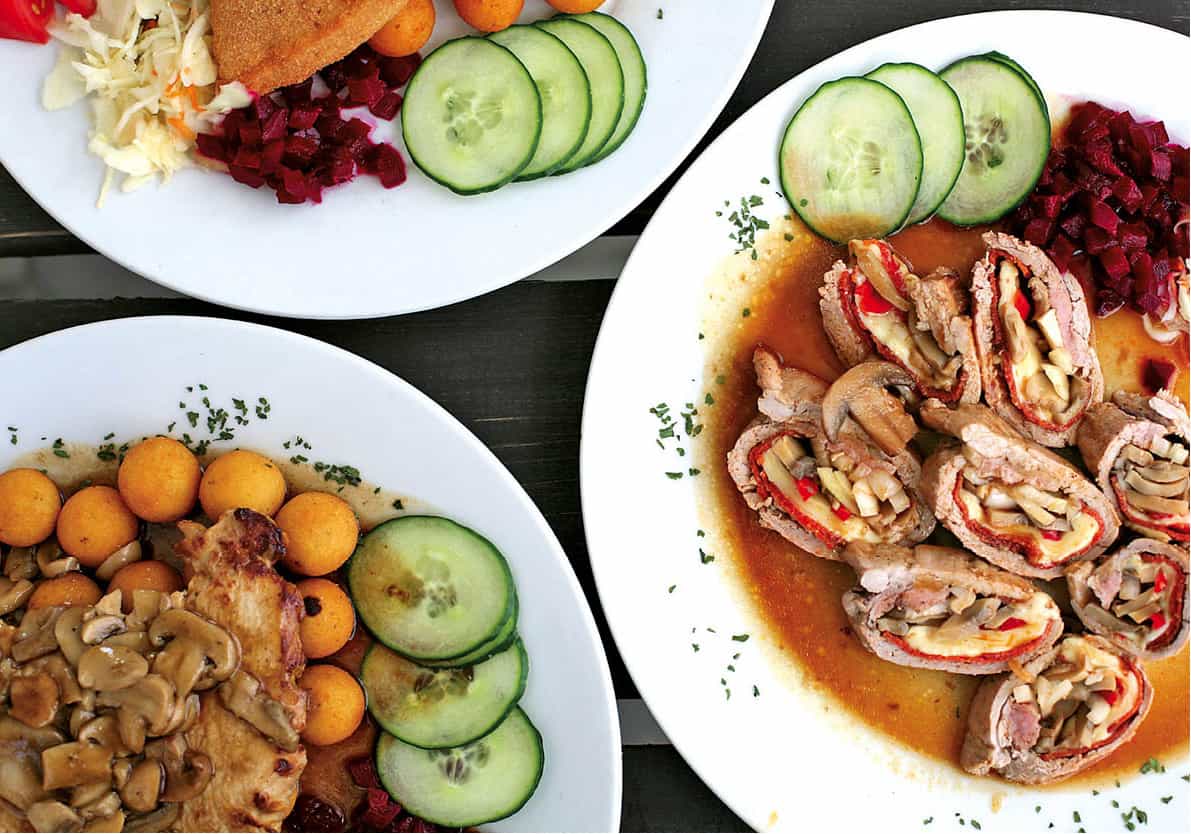
A variety of tempting dishes
iStock
Czech cuisine
On weekdays, most Czechs eat early – generally at around 7pm – then head to bed in preparation for the working day ahead. However, restaurants in Prague stay open until around 10pm or 11pm, and even later at weekends, when locals go out to enjoy themselves.
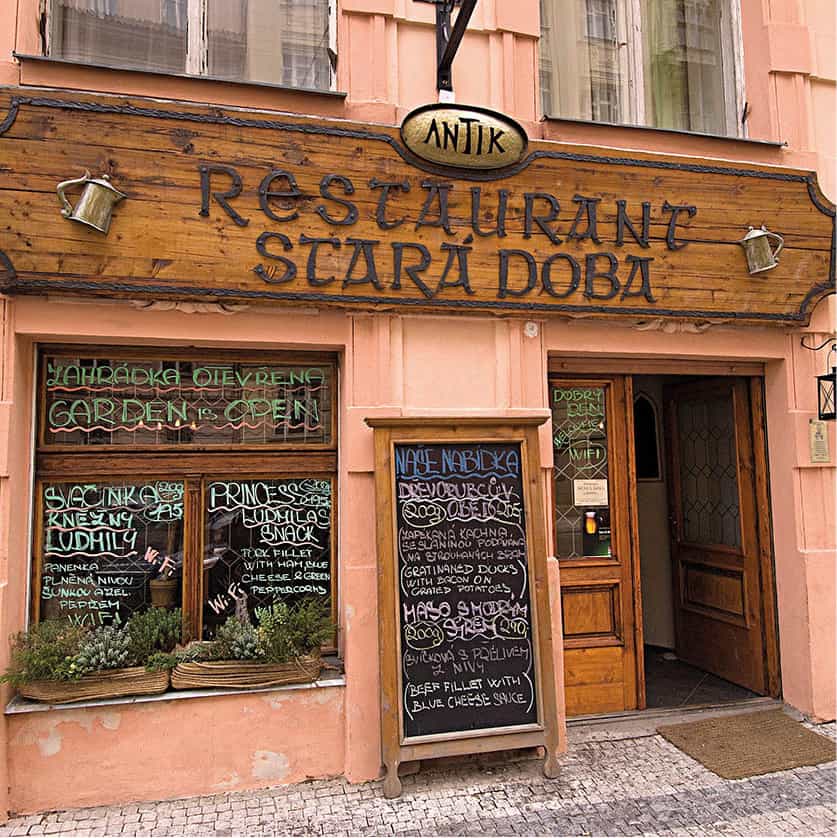
A traditional restaurant in Nové Město
Rod Purcell/Apa Publications
Most restaurants post a printed menu (jídelní lístek) near the door, giving you at least an idea of their prices. Nowadays, most cheap, medium-priced and first-class restaurants tend to have menus in English and German as well as Czech.
A menu might be divided into the following categories: studená jídla (cold dishes), polévky (soups), teplé předkrmy (warm starters), ryby (fish), drůbež (poultry), hotová jídla (main courses), and moučníky (desserts). A growing number of establishments are offering set meals at lunchtime and in the evening in addition to à la carte.
Try a starter of Prague ham (Pražská šunka), a succulent local speciality. It might come served in thin slices, garnished with cucumber and horseradish; with cheese in miniature sandwiches; or folded into horns and stuffed with cream or cream cheese and horseradish.
Soup is a popular choice at both lunch (oběd) and dinner (večeře). Either a fairly light bouillon or, as is more likely, a thick, wholesome soup of potatoes, vegetables and perhaps some meat. A spoonful of whipped cream may also be added. One of the heartiest traditional recipes is bramborová polévka s houbami (potato soup with mushrooms). This thick soup flavoured with onion, bacon, carrots, cabbage, parsley and spices can constitute a meal in itself.
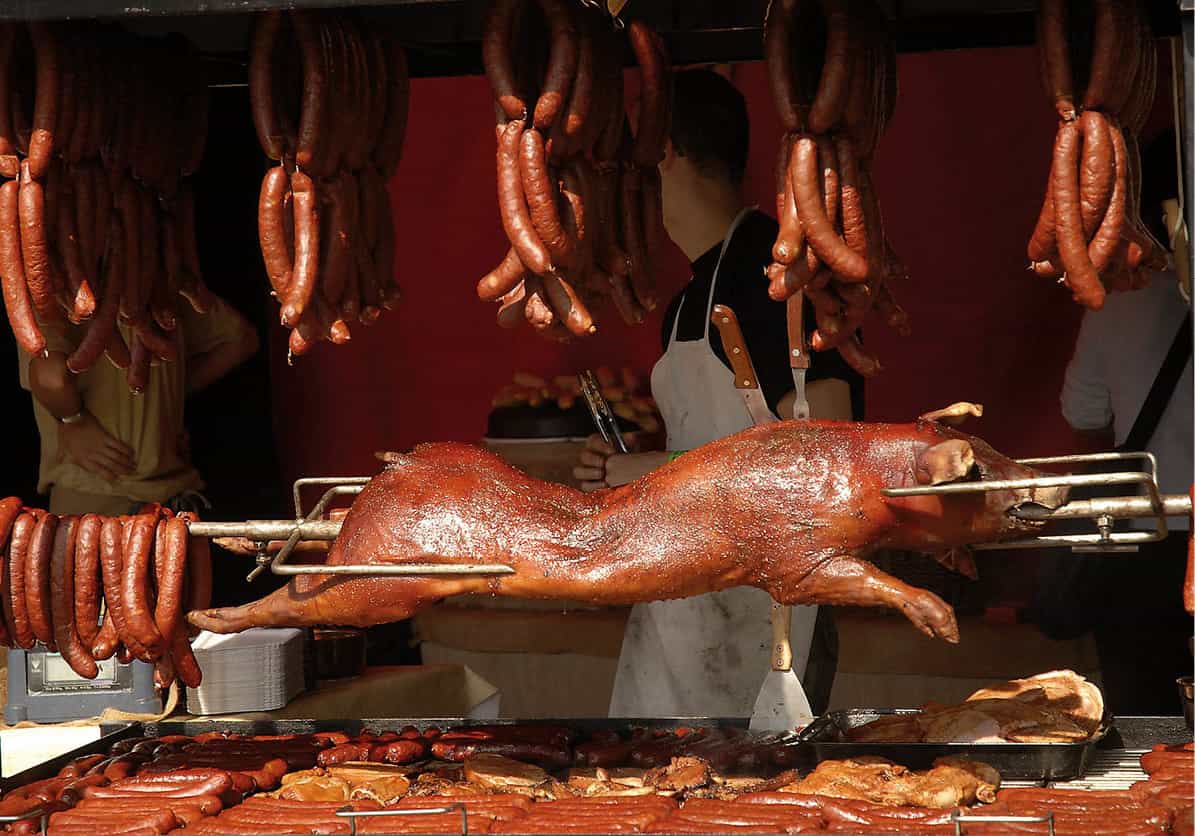
The Czechs love their pork
Apa Publications
The hearty Czech cuisine typically centres on well-roasted pork or beef with thick gravy. This is supplemented with poultry, game or fish dishes – owing to the tradition of seasonal hunting in the surrounding countryside. The generally heavy, savoury food goes down best with cold Czech beer, a brew long held in high esteem by gourmets everywhere.
Meat forms the backbone of Czech cuisine. Always thoroughly cooked, it can be roasted or grilled. The succulent Pražská hovězí pečeně (Prague roast beef), a joint of beef stuffed with fried diced ham, peas, egg, onion and spices, is one of the most popular dishes. Also look out for svíčková pečeně na smetaně, tasty beef in a cream sauce.
Another gourmet favourite is Šunka po staročesku (boiled ham), with a sauce of plums, prunes, walnut kernels and wine. For a taste of the Austro-Hungarian Empire, you should sample some gulaš (goulash), a stew flavoured with paprika, or smažený řízek (Wiener schnitzel), a delicious breaded veal escalope. Poultry and game are also popular, and depending on the season you will find duck, goose, boar and venison on the menu.
As an accompaniment, pride of place goes to the dumpling. Either made from bread (houskové knedlíky, relatively light) or potato (bramborové knedlíky, heavier in texture) you will usually find one or two sliced dumplings on your plate. Vegetables have always played a secondary role in traditional cuisine, and when they do appear in soups and stews seem overcooked. You will often see ‘stewed vegetables’ on menus in English, which forewarns you that they will definitely not be arriving al dente. Sauerkraut (kyselé zelí) is the most commonly served – red or white cabbage cooked to a melting consistency in animal fat, sugar and a little wine.
Desserts usually figure in the heavyweight category, for example the tasty jablkový závin (apple strudel), with a topping of whipped cream. A slightly more delicate variation, jablka v županu (apple baked in flaky pastry) uses whole apples stuffed with sugar, cinnamon and raisins. Svestkové knedlíky (plum dumplings) are sprinkled with cheese curd and sugar, and then doused in melted butter. A firm favourite is palačinka, ice cream or cream and fruit enveloped in a pancake. Finally, zmrzlina (ice cream) or kompot (stewed fruit) – sometimes laced with fruit brandy – are old stand-bys.
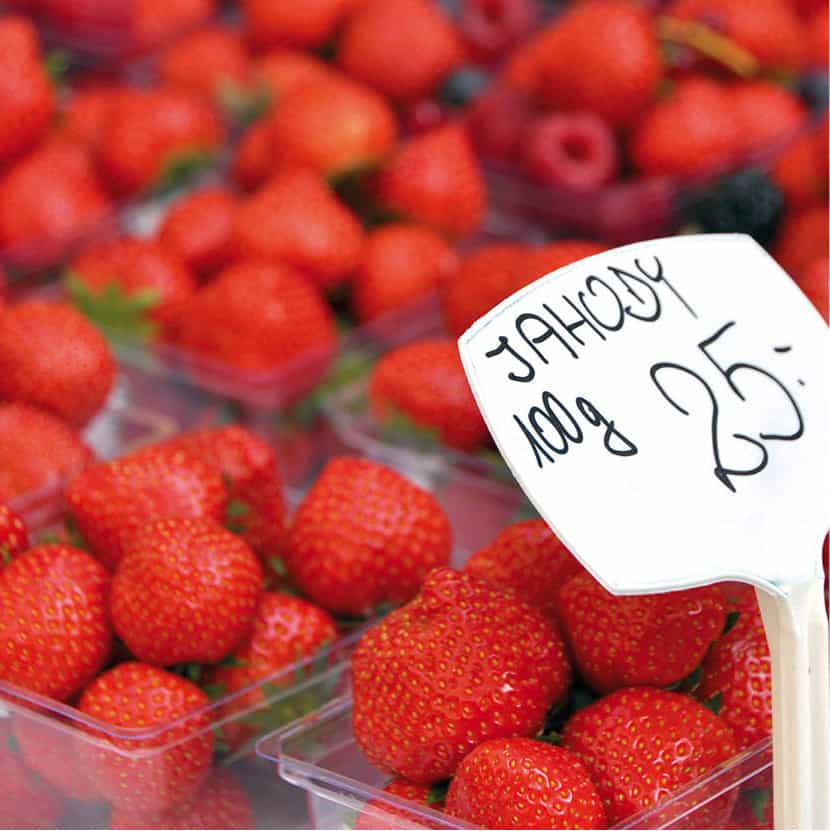
Prague’s Havelská Market is crammed with fresh produce
iStock
Vegetarian cooking
The presence of a large expatriate community has led to the emergence of several vegetarian cafés and restaurants over the past few years. Consequently, many non-vegetarian restaurants now offer a range of options bez masa (without meat). One of the best places for vegetarian food is Estrella (Opatovická 159/17, tel: 777 431 344; www.estrellarestaurant.cz; Mon–Sun 11.30am–3.30pm and 6–10pm), which serves excellent, good-value vegetarian fare.
Snacks
Prague is an ideal place for inexpensive snacks or lunch on the move, bought from one of the city’s street stands. A bramborák is a savoury potato pancake served on a square of paper, delicious despite the greasy fingers. Pečená klobása (roasted sausage) rates a paper plate, a slice of rye bread and a squirt of mild mustard – but no fork or knife. They also come hot-dog-style with onions and mustard. Smažený sýr is a kind of vegetarian Wienerschnitzel consisting of a slice of fried cheese. Chlebíčky, or open sandwiches with a variety of toppings, are also popular in snack bars. You may be offered them if you are invited to a Czech home. American-style fast-food outlets are plentiful, particularly around Wenceslas Square, and more popular with young Czechs than the traditional snack outlets. Gorgeous ice cream is sold everywhere.
The art of drinking
Beer halls are a veritable institution in Bohemia, so much so that some unwritten rules of conduct have evolved over the centuries. This special brand of etiquette dictates that if a man and a woman arrive at a pub together, the man should always enter before the woman in case there is a brawl going on inside.
Never bother the waiter, and ask for his assistance before moving any of the chairs. Place a beer mat on the table to indicate that you are ready to order. Don’t tip too much (a few crowns will do) or you’ll be seen as arrogant. Always raise your glass to your neighbours before drinking and look them square in the eye. And finally, never complain that your beer has too much of a head – it’s the local custom.
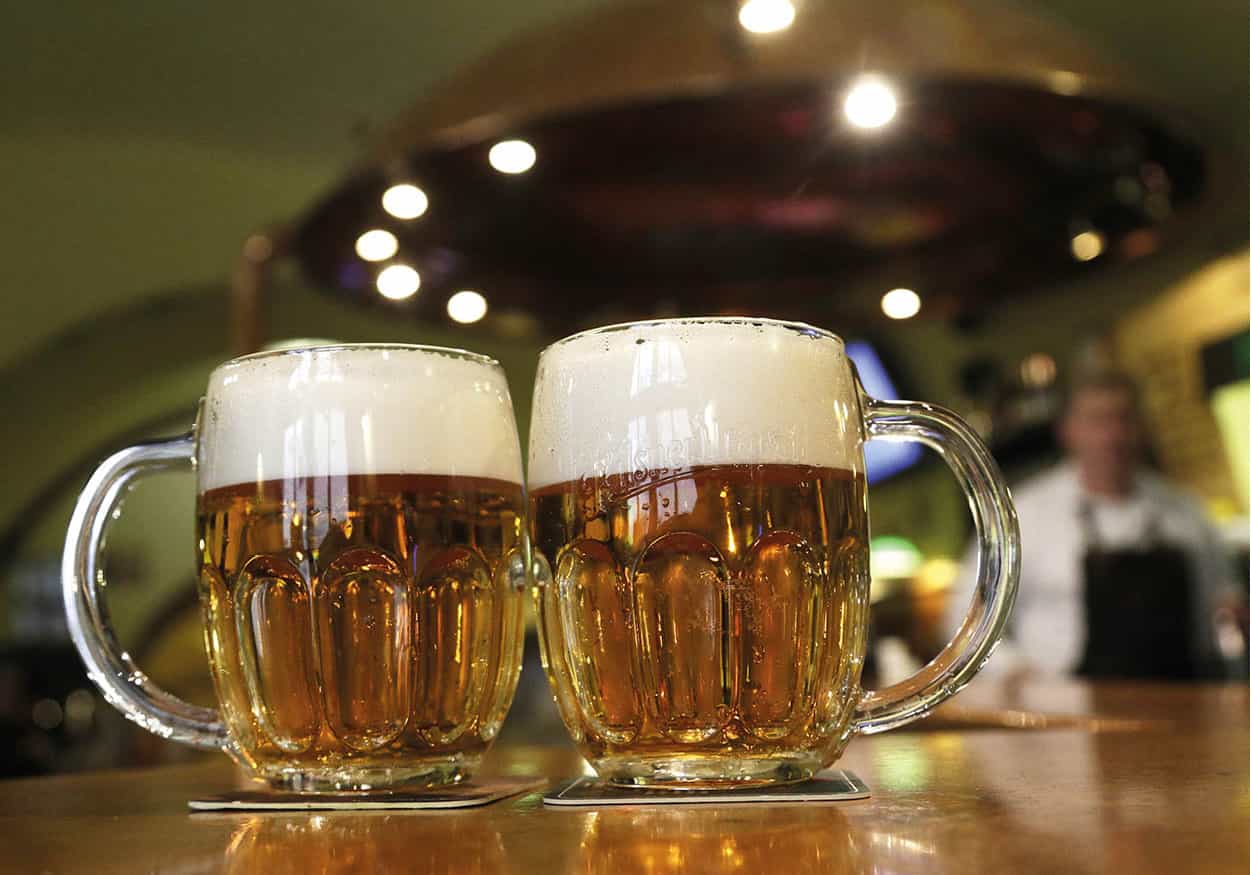
Czech beer has a reputation to be envied
Shutterstock
Drinks
Prague offers a wonderful selection of places to drink, of which a large number also serve light meals, and its architectural wealth ensures a range of superb settings. In addition to this, the city has recently started to witness the re-emergence of the thriving café society of the early 20th century.
Czech beer (pivo) has a reputation to be envied, and the intense brewing activity in the city of Plzeň (Pilsen) has given the world the pilsner style of lager, imitated by many other countries. Naturally, local people are adamant that no other beer tastes quite the same because Plzeň beer gets its distinctive flavour from the alkaline water and the excellence of its hops, a key ingredient, which grow on vast wood-and-wire frames in the Bohemian countryside. The most famous beers are Pilsner Urquell from Plzeň, Budweiser Budvar from České Budějovice (Budweis) and Staropramen from Prague.
Other well-regarded breweries abound in Prague and the smaller surrounding towns. Several pubs brew their own light (světle) or dark (tmave) blends, including U Fleků which has been in operation since 1499. All Czech beer is tasty and refreshing but it might be wise to bear in mind that it is probably stronger than what you are used to drinking at home.
Viticulture
Although Bohemia produces some excellent wines, the Czech Republic’s best vintages tend to come from Moravia, in the country’s east, where the gentle slopes enjoy better sunshine, producing sweeter grapes. To be sure of buying a good bottle, seek advice from a reputable merchant, such as Cellarius in the Lucerna arcade (www.cellarius.cz).
Czech wine (víno) is virtually unknown abroad, so it’s likely that you will discover something new and pleasing without having to search very hard. Bohemia produces only a small proportion of the country’s total wine output: most of it comes from Moravia. White is bílé and red is červené.
A drink local to Karlovy Vary, becherovka is made of herbs and served chilled as an aperitif, as is the powerful, sweetish stará myslivecká. After-dinner drinks generally take the form of fruit brandies (or schnapps), especially slivovice which is made from plums.